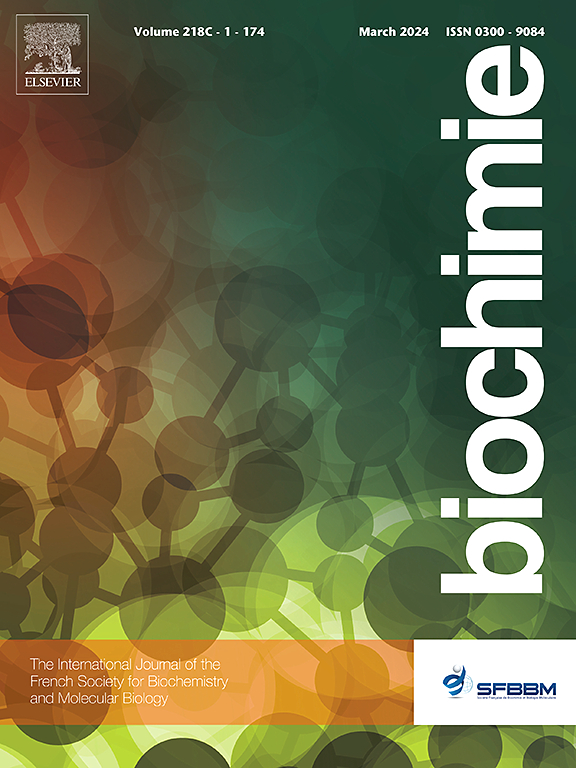Screening inhibitory peptides against sphingomyelinase D from the livestock tick Rhipicephalus microplus using phage display technology
IF 3
3区 生物学
Q2 BIOCHEMISTRY & MOLECULAR BIOLOGY
引用次数: 0
Abstract
The cattle tick Rhipicephalus microplus, which is distributed worldwide, causes significant economic loss to the livestock industry. A sphingomyelinase (SMase) D-like protein was previously identified in R. microplus saliva (RmSMase) and characterized in terms of its cofactors, optimum pH, and products generated from sphingomyelin hydrolysis. SMases are present in the venom of spiders from Loxosceles spp. and in the digestive system of non-venomous spiders from Uloborus spp. and are secreted by pathogenic bacteria. In this study A peptide library was screened using Phage Display technology and two out of the three peptides synthesized showed inhibitory activity against RmSMase with sphingomyelin as the substrate. Two of the three synthesized peptides showed inhibitory activity against RmSMase. Docking analysis suggested that the peptides block access of the substrate to the catalytic site. The RWLWWLW peptide showed competitive behavior (Ki = 5.35 ± 0.46 μM), whereas WLSWLW showed competitive inhibition behavior (Ki = 29.54 ± 6.11 μM). Both RWLWWLW and WLSWLW also inhibited the activity of SMase C from the bacterial pathogen Bacillus cereus, presenting IC50 values of 4.99 ± 0.07 and 16.94 ± 8.71 μM, respectively. Because SMases have been suggested to be involved in the development of Alzheimer's disease, major depression, and cerebral ischemia, the discovery and characterization of new SMase inhibitors may contribute to the development of alternative treatments. This is the first study to identify peptide inhibitors against tick SMase using phage display technology.

利用噬菌体展示技术筛选家畜小头蜱鞘磷脂酶D抑制肽。
分布在世界各地的牛蜱小头蜱给畜牧业造成了重大的经济损失。一种鞘磷脂酶(SMase) d样蛋白先前在微鼠唾液(RmSMase)中被发现,并根据其辅因子、最适pH值和鞘磷脂水解产物进行了表征。SMases存在于Loxosceles spp.蜘蛛的毒液中,也存在于Uloborus spp.无毒蜘蛛的消化系统中,由致病菌分泌。本研究利用噬菌体展示技术筛选了一个肽库,以鞘磷脂为底物合成的3个肽中有2个对RmSMase具有抑制活性。三个合成的肽中有两个显示出对RmSMase的抑制活性。对接分析表明,肽阻断了底物通往催化位点的通道。RWLWWLW表现出竞争性抑制行为(Ki = 5.35±0.46 μM), WLSWLW表现出竞争性抑制行为(Ki = 29.54±6.11 μM)。RWLWWLW和WLSWLW还能抑制蜡样芽孢杆菌SMase C的活性,IC50值分别为4.99±0.07 μM和16.94±8.71 μM。由于SMases被认为与阿尔茨海默病、重度抑郁症和脑缺血的发展有关,新的SMase抑制剂的发现和表征可能有助于开发替代治疗方法。这是首次利用噬菌体展示技术鉴定抗蜱虫SMase肽抑制剂的研究。
本文章由计算机程序翻译,如有差异,请以英文原文为准。
求助全文
约1分钟内获得全文
求助全文
来源期刊

Biochimie
生物-生化与分子生物学
CiteScore
7.20
自引率
2.60%
发文量
219
审稿时长
40 days
期刊介绍:
Biochimie publishes original research articles, short communications, review articles, graphical reviews, mini-reviews, and hypotheses in the broad areas of biology, including biochemistry, enzymology, molecular and cell biology, metabolic regulation, genetics, immunology, microbiology, structural biology, genomics, proteomics, and molecular mechanisms of disease. Biochimie publishes exclusively in English.
Articles are subject to peer review, and must satisfy the requirements of originality, high scientific integrity and general interest to a broad range of readers. Submissions that are judged to be of sound scientific and technical quality but do not fully satisfy the requirements for publication in Biochimie may benefit from a transfer service to a more suitable journal within the same subject area.
 求助内容:
求助内容: 应助结果提醒方式:
应助结果提醒方式:


